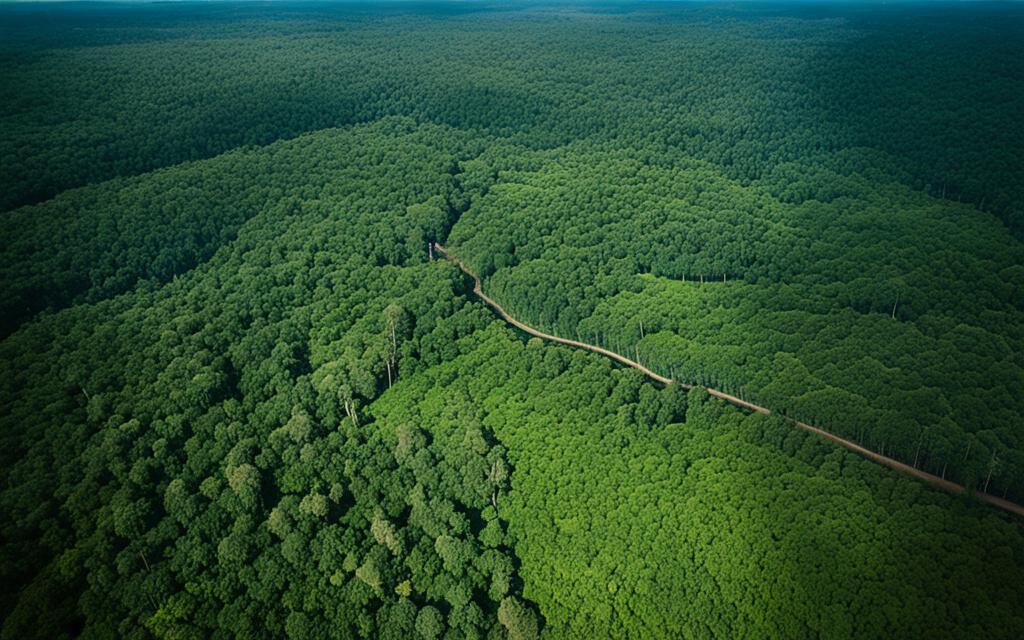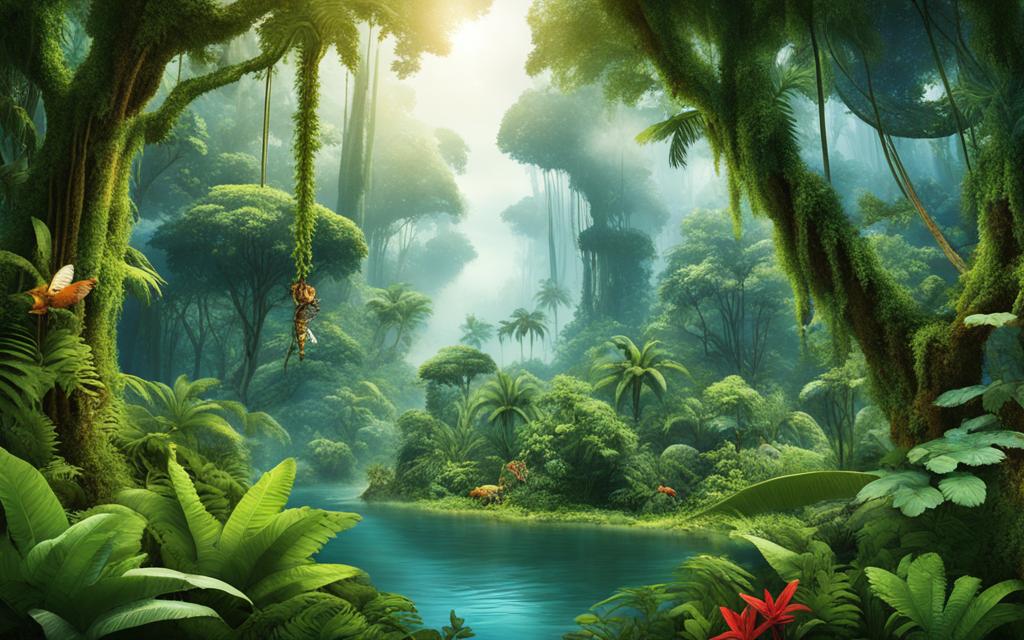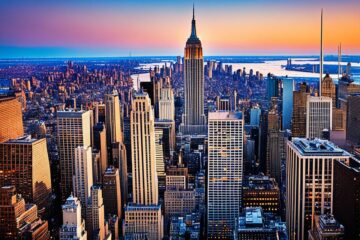As the sun peeked through the dense, greenery, Karina was amazed. She stood in the Amazon Rainforest, the Earth’s biggest tropical rainforest. It’s known as “the lungs of the Earth” for its massive impact on our planet. This place spans over nine countries, showing us a rich mix of plants, animals, and people living together.
Karina saw more than a faraway wonder. To her, it symbolized our planet’s strength and its need for balance. She was surrounded by tall trees and the songs of countless birds. It made her feel truly connected to this special part of the Earth.
But, the Amazon Rainforest faces big risks like deforestation. This happens a lot because of agricultural growth, logging, and building roads and cities. It’s crucial to save this natural wonder. Doing so helps us keep the Earth’s balance and protect our future.
Key Takeaways
- The Amazon Rainforest is the world’s largest tropical rainforest, spanning across nine countries in South America.
- It is often referred to as “the lungs of the Earth” due to its crucial role in absorbing and storing carbon dioxide, helping to mitigate the effects of climate change.
- The Amazon is home to an astounding variety of plant and animal life, as well as indigenous communities that have lived in harmony with the forest for centuries.
- However, the Amazon is facing increasing threats from deforestation, driven by factors such as agricultural expansion, logging, and infrastructure development.
- Protecting and preserving the Amazon Rainforest is essential for maintaining the delicate balance of our planet’s ecosystems and safeguarding the future of our world.
The Amazon Rainforest: A Vast and Biodiverse Ecosystem
The Amazon Rainforest is a huge and interconnected area in South America. It goes through nine countries. These include Brazil, Peru, and others. It’s an amazing place, filled with a wide variety of plants and animals.
Spanning Multiple Countries
The Amazon Rainforest is about 2.1 million square miles big. That makes it the world’s largest tropical rainforest. It spreads across different nations, which are all working to protect it.
Home to Millions of Species
This area is famous for its incredible number of species. There are about 10 million kinds of plants and animals living here. Many of these are yet to be found. It is truly a treasure of nature, with many unique and rare species.
A Critical Carbon Sink
The Amazon Rainforest also helps our planet in a big way. It absorbs a lot of carbon dioxide from the air. This process has a positive effect on our climate. So, it’s key in balancing our planet’s environment.
Deforestation: A Looming Threat
Despite its critical role, the Amazon Rainforest faces a big threat from deforestation. This threat comes from agricultural expansion, logging, mining, and infrastructure development. These activities quickly change the land and harm the forest’s fragile ecosystems.
Causes and Consequences
When we lose this important carbon sink, it has wide effects. It adds to climate change, causes habitat destruction, and displaces indigenous communities. These communities have lived in the Amazon for many years. The loss not only hurts the area’s unique biodiversity, but also challenges worldwide efforts to fight climate change.
Impact on Indigenous Communities
For indigenous communities, the effect of deforestation is very damaging. They depend on the forest for their lives, culture, and spiritual health. By stopping deforestation in the Amazon, we can help keep its biodiversity, protect the rights of indigenous peoples, and lessen the global effects of climate change.

Exploring the Amazon’s Wonders
Despite big threats, the Amazon Rainforest stands as a unique place to explore and find new things. Ecotourism is a great, earth-friendly way for people to see the amazing parts of the Amazon while helping protect it and supporting local indigenous cultures.
Ecotourism and Sustainable Travel
Guided walks in the thick jungle or canoe rides on curved rivers offer a close look at the Amazon Rainforest’s diverse life. Travelers get to know the indigenous communities living there, too. By using sustainable tourism practices and giving power to locals, Amazon ecotourism helps safeguard the forest’s balance and raises the alarm to protect this global treasure.
Connecting with Nature
Visitors deeply engage with the Amazon Rainforest through special experiences, linking them closer to nature. This builds respect for environmental protection and the value of living in balance with nature. Meeting local indigenous cultures teaches people the traditional ways of living that have harmonized with the Amazon for ages.
The Amazon Rainforest: Conservation Efforts and Sustainable Development
There is an urgent need to protect the Amazon Rainforest. Many efforts and initiatives are focusing on conservation and sustainable development. They aim to keep the forest’s biodiversity safe, help indigenous communities protect their rights and support their way of life, and encourage earth-friendly business. This balance supports both people and nature.
Protecting Biodiversity
There are new ideas that aim to protect nature, help people, and grow the economy. These efforts look to create balance. They invest in ways of farming and forestry that protect the Amazon Rainforest’s unique life forms.
Empowering Local Communities
It’s also important to make indigenous communities strong. They’ve protected the Amazon Rainforest for a long time. These efforts support the rights and the way of life of these groups. They make sure these groups help make decisions that affect them, keeping the forest safe for the future.
Conservation Efforts and Sustainable Development
By working together across the world, the Amazon Rainforest is doing better. It’s on the path to staying healthy and strong for years to come. This work is very important. It protects a place that helps control the world’s climate and keeps our planet healthy for everyone.

Climate Change and the Amazon’s Future
The Amazon Rainforest is strong yet at risk because of climate change. It’s a vast, connected ecosystem that controls the world’s climate. But, deforestation, drought, and higher temperatures threaten its balance. This could have very bad effects on our planet.
The Amazon’s ability to capture carbon is crucial. If it’s lost, global warming could speed up. Also, changes in the rainforest’s water cycle might affect weather and farming. It’s urgent to save the Amazon Rainforest. It’s important for its beauty and for the health of our planet.
Resilience and Vulnerability
The Amazon Rainforest can withstand a lot, but it’s getting more fragile. It faces dangers like deforestation and changing weather, all made worse by climate change.
Global Impact
The Amazon Rainforest is key in fighting global warming. Losing its role as a carbon sink would hurt the whole planet. It could speed up global warming and upset our climate’s balance.
Urgent Call to Action
Defending the Amazon Rainforest is a duty for everyone worldwide. We must fight deforestation, back sustainable development, and protect this important environmental place. The Amazon‘s future and our planet’s are linked. We need to act right now.
Conclusion
The Amazon Rainforest is facing a vital moment. It’s the biggest tropical rainforest, acting as a key carbon sink. This is crucial for our planet’s climate and biodiversity. However, it’s threatened by deforestation. This is due to things like farming, logging, and building.
Combating these threats needs a mix of actions. This includes conservation efforts, sustainable development initiatives, and global teamwork. Protecting the rainforest’s plants and animals is essential. So is helping the local people and fighting climate change. We must act now to save the Amazon Rainforest and our world’s future.
By focusing on environmental protection and sustainable development, we can save the Amazon. This means ensuring the forest and its creatures thrive for years to come. Let’s join forces to turn the Amazon’s problems into chances for good. Together, we can keep this precious ecosystem healthy, benefiting our planet for future generations.




